Ray Tracing Performance
We are going to focus on Ray Tracing 1440p gameplay performance with the SAPPHIRE NITRO+ AMD Radeon RX 6750 XT GAMING OC 12GB video card. We will include DLSS and FSR performance on the same graph in the games that are supported. We will use DLSS on NVIDIA GPUs and FSR on AMD GPUs. For video card comparisons we are using an AMD Radeon RX 6700 XT video card and an NVIDIA GeForce RTX 3060 Ti FE video card.
Our focus today, in this initial review, is to first find out the playable gameplay experience of the SAPPHIRE NITRO+ Radeon RX 6750 XT and what level of game quality settings and performance it gives us. We also want to find out what the difference is compared to the AMD Radeon RX 6700 XT, and how much performance we can squeeze out of the video card overclocked. We want to see how much more performance it offers with the faster clock and memory. The GeForce RTX 3060 Ti is included as a reference point. We will perform further, specific comparisons, to other GPUs in a follow-up “vs” style comparison.
Dying Light 2
Dying Light 2 was released in February 2022 on the PC and uses Techland’s C-Engine. The game supports Ray Tracing, DLSS and FSR. This game supports Ray Tracing environmental effects including Ray Traced Soft Shadows, Ray Traced Ambient Occlusion, Ray Traced Global Illumination, and Ray Traced Reflections. We utilize the built-in preset option to set “HIGH QUALITY RAYTRACING” which enables the games highest graphics settings plus the environmental effects explained above at the highest values. The game is run in DX12 Ultimate mode with ASYNC Compute turned on. For our benchmark, we are using a custom manual run-through at the end of the game hopping between rooftops, as well as free-roaming on the ground city level, as well as a forested area, in the daylight.
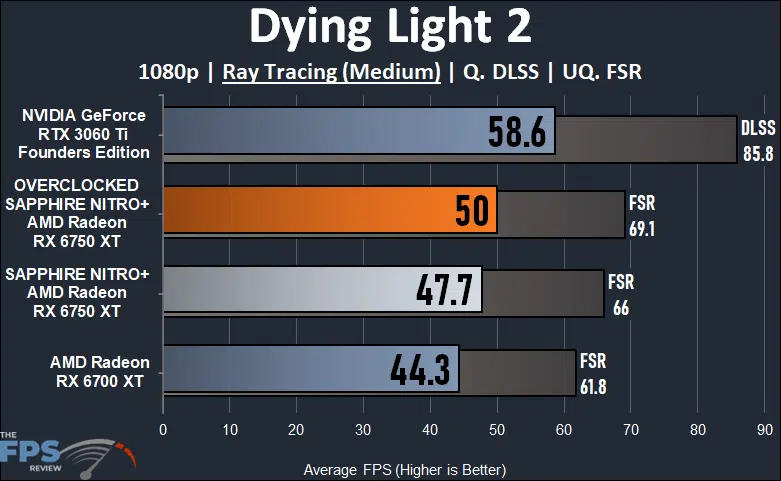
With the SAPPHIRE NITRO+ Radeon RX 6750 XT video card, in order to play with Ray Tracing in Dying Light 2 we had to lower the resolution to 1080p and play on the “Medium” Ray Tracing option in the game. This enables Ray Tracing, but not on everything, and does lower some other settings down to “Medium.” However, that had to do done to get the game to be playable, and as you can see it’s around 47.7FPS average. This is 8% faster than the Radeon RX 6700 XT, which was not very playable. Overclocking the SAPPHIRE NITRO+ really helped and brought us to 50FPS, an improvement of 5%. But to really enjoy Ray Tracing you will end up having to use FSR to get framerates over 60FPS. The RTX 3060 Ti is faster, as it is faster at Ray Tracing, it’s faster than the 6750 XT by 23%.
Far Cry 6
Far Cry 6 was released in October of 2021 and uses the Dunia Engine. We utilize the built-in benchmark for testing. We have the HD Texture pack installed and turned on. We utilize the “Ultra” graphics preset which sets all options to the highest game settings. This game supports Ray Tracing via two DXR settings, one for Reflections and the other for Shadows, we turn on both for testing. This game supports FSR upscaling.
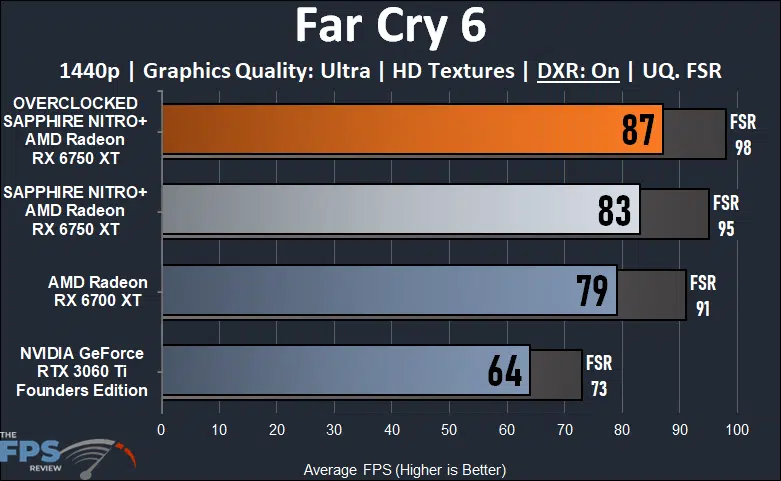
Far Cry 6 ran so well with Ray Tracing that we could keep the game at 1440p on the SAPPHIRE NITRO+ Radeon RX 6750 XT video card. With all DXR turned on, HD Textures, and the highest in-game settings we got over 80FPS on it, which is very good. It was about 5% faster than the Radeon RX 6700 XT. Overclocking the video card improved performance by 5% and was the fastest card here. It was also 30% faster than the RTX 3060 Ti, though that may be due to a VRAM bottleneck on the RTX 3060 Ti, the 12GB of VRAM on the RX 6750 XT is paying off here allowing these high settings at 1440p.
Cyberpunk 2077
Cyberpunk 2077 was released in December of 2020 and uses the REDengine 4. We have the game patched to version 1.52 and perform a long manual run-through driving in the game’s open world. We test using the Graphics Preset option to set graphics settings. We use the Ray Tracing Graphics Preset of either: “Ray Tracing: Low”, or “Ray Tracing: Medium” or “Ray Tracing: Ultra” as indicated. This game supports DLSS and FSR.
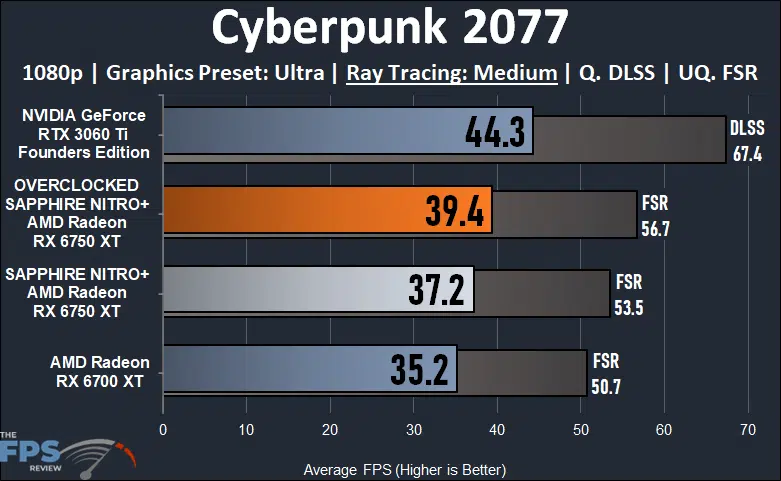
Similar to Dying Light 2, we had to lower the resolution and Ray Tracing setting to even get some form of playable settings, and even then it was only combined with FSR. At 1080p and “Medium” Ray Tracing the SAPPHIRE NITRO+ Radeon RX 6750 XT produced 37FPS, and this really was not playable. Even overclocked, while it improved performance, it was not playable. Compared to the Radeon RX 6700 XT the SAPPHIRE NITRO+ RX 6750 XT was 6% faster. The RTX 3060 Ti was the fastest card, but that is because it was just faster at Ray Tracing compared to the Radeon cards here. Once we turned on FSR, then the SAPPHIRE NITRO+ Radeon RX 6750 XT was playable and even better with it overclocked. It was pretty decent in performance overclocked with FSR, but it took all of that just to get it to some form of playability with Ray Tracing “Medium” in this game at 1080p.
Watch Dogs Legion
Watch Dogs Legion was released on the PC in October of 2020 and uses the Disrupt game engine. We utilize the built-in benchmark for testing. We have the HD Texture pack installed and enabled for testing. We use the built-in graphics preset of “Ultra” for testing. We utilize the “Ultra” preset quality option for Ray Tracing. This game supports DLSS upscaling.
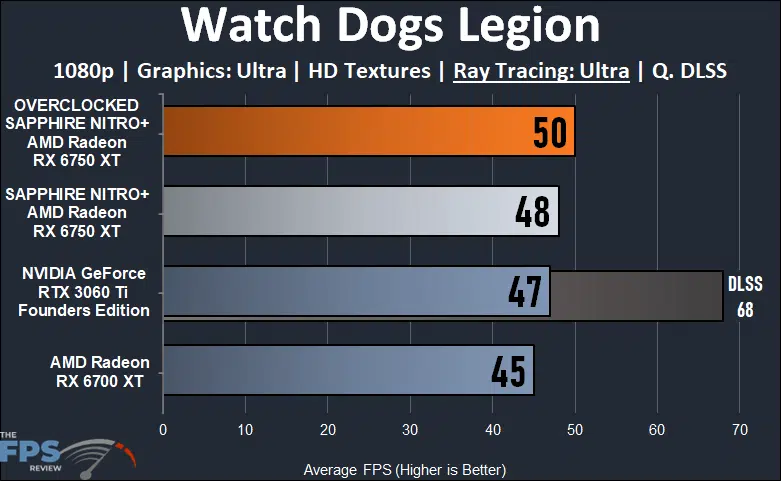
We were surprised how well Watch Dogs Legion actually did with “Ultra” Ray Tracing turned on, though we did have to drop the resolution to 1080p. The SAPPHIRE NITRO+ Radeon RX 6750 XT was at 48FPS, which was faster than the RX 6700 XT. Overclocking it brought performance up to 50FPS and the game playability wasn’t too bad. The RTX 3060 Ti did not even beat it this time until of course we enabled DLSS with it.
Metro Exodus Enhanced
Metro Exodus Enhanced is being run with Shading Quality at “Extreme” and Ray Tracing at “Ultra.” This is a demanding game, that heavily focuses on Ray Tracing utilization, including Global Illumination. We are utilizing the built-in benchmark.
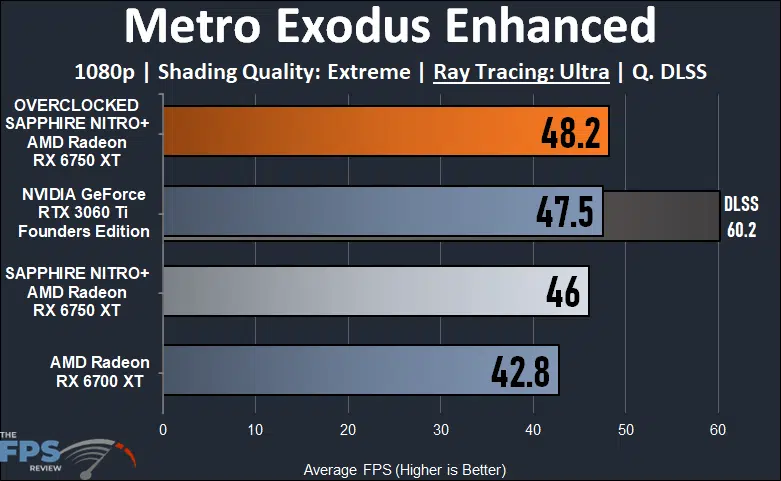
We also experienced better than expected results in Metro Exodus Enhanced, though we once again did have to lower it to 1080p. The SAPPHIRE NITRO+ Radeon RX 6750 XT produced around 46FPS, which was 7% faster than the Radeon RX 6700 XT. But once we overclocked it, performance increased by 5% and it was now actually faster than the RTX 3060 Ti, that is until we turned on DLSS.
